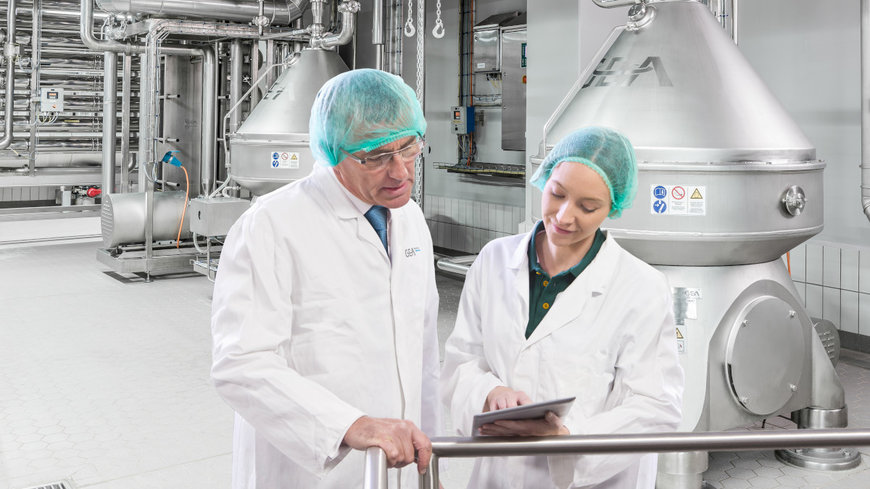www.magazine-industry-usa.com
30
'20
Written on Modified on
Optimum separation instead of repair: GEA takes the next step in data utilization with Industrial Analytics from Weidmüller
The possibility of increasing one's own efficiency and productivity through data collection and analysis, as well as developing new business models, fires the imagination of machine and plant manufacturers looking for new growth and profit opportunities.

GEA has also been involved in the field of condition monitoring for some time. With Weidmüller's new Automated Machine Learning Software, GEA intends to expand and enhance its range of services in terms of systems and plants. A corresponding "pilot" has been initiated at GEA's Oelde site.
Industry 4.0 as a challenge and great opportunity
Digital technologies and the topic of Industry 4.0 pose great challenges for companies in the mechanical and plant engineering sector, but also offer completely new opportunities: Production plants must be individually adaptable to individual products and customer requirements. The service business is becoming increasingly interesting. "We have been dealing with the topic of condition monitoring and condition monitoring of machines and have set up threshold value analyses for quite some time. But we were aware that the potential of this topic is much greater," explains Kerstin Altenseuer, Head of Service Development at GEA. "In the long term, the aim was to map processes or to be able to optimize applications together with our customers. And of course also to establish new business models and areas of application such as leasing or subscription models for our machines".
Making algorithm know-how available
GEA, with over 125 years of expertise in the manufacture of separators and decanters for the separation of liquids, benefits enormously from this experience. These plants are used in various industries such as the food industry, chemicals, pharmaceuticals, biotechnology, energy, shipping and environmental technology. With new business models or applications, the company intends to open up new sources of revenue. "However, we realised relatively quickly that we needed the expertise and help of data experts for this project. "It is not easy to identify and recruit the appropriate experts, i.e. data scientists, even if a company like GEA would in principle have good cards. But we would have needed several, which doesn't make things any easier," says Kerstin Altenseuer.
Together instead of alone
So how can you build up expertise with appropriate experts? In its search for a solution to this problem, GEA became aware of Weidmüller and the company's expertise in the field of industrial analytics through the "It's OWL" excellence cluster. The goal: to think differently about the service offering for customers and establish smart services. At the same time, the quality and performance of the machines was to be improved and the basis for developing new business models created in order to position GEA competitively in the market.
Transforming process engineers' findings into algorithms
Gea and Weidmüller first worked on how the project could be set up and what the central goal would be. "It quickly became clear that we would first prove the feasibility in a proof of concept and then enable Gea to develop and operate ML models independently. ", explains Tobias Gaukstern, Business Unit Head of Industrial Analytics at Weidmüller. With the help of the Automated Machine Learning Software Service, the experts at GEA should be able to train machine learning algorithms and statistical models independently. "The AutoML tool simplifies and accelerates the application of ML for application experts, without the expert knowledge in ML being necessary," explains Tobias Gaukstern.
Mechanical engineers often face the problem that their design, automation and process experts cannot easily transfer their knowledge into machine learning solutions. How do you bundle this application knowledge in software or even in an algorithm? "The solution was very interesting for us because we have many process engineers who know the machines very well and can interpret the data to a certain extent.
With Weidmüller's help we can now transfer this knowledge into an algorithm," explains Matthias Heinrich, Manager Digital Solutions at GEA. A proof of concept (PoC) with historical data was carried out in Oelde to check how the theoretical considerations can be applied on site in the production environment at GEA. The aim was to automatically detect anomalies in the behavior of separators in the dairy industry.
Advantage close cooperation and regional proximity between the partners
That the project was a complete success was also due to the good and close cooperation within the teams. On the one hand, the regional proximity was a great advantage, because the project team was able to get together easily and quickly to discuss individual aspects. "Weidmüller also has a very broad data scientist perspective. At the same time, as a mechanical engineer you feel well understood because you don't just sit down with IT specialists but with engineers who know the machines," explains Kerstin Altenseuer.
Within the scope of the project, GEA provided the input and the requirements, and Weidmüller then implemented the 'proof of concept'. "This division of labour has proven to be very effective. We had regular, good coordination and very good results, which formed the basis for the pilot application and finally the transfer served the series," Tobias Gaukstern also points out.
Further rollout planned
The applications were used in connection with an existing IoT scenario for condition monitoring at GEA. "Everyone is talking about digitization. But in the end, we want to provide added value. We want to take the next step with Weidmüller's solution," says Kerstin Altenseuer. Until then, a number of tasks still need to be completed, such as improving data connectivity and data quality, before we can get started. "So far we have connected 500 machines in the existing portal and we want to transfer Weidmüller's solution to these machines as quickly as possible," explains Kerstin Altenseuer. And she looks to the future: "I also see great potential for transferring the new technology to other areas at GEA.”
www.gea.com

